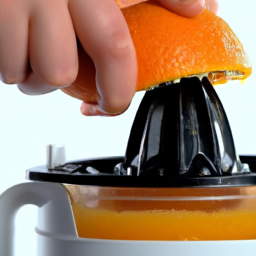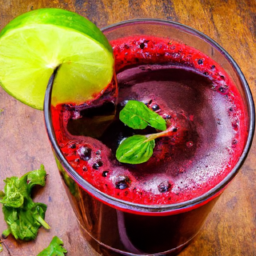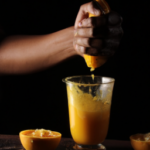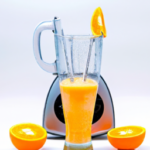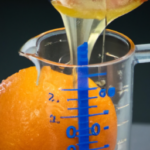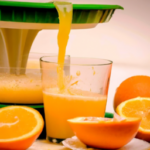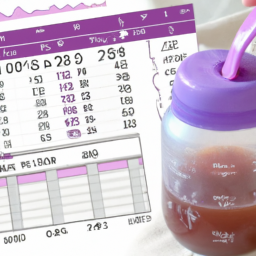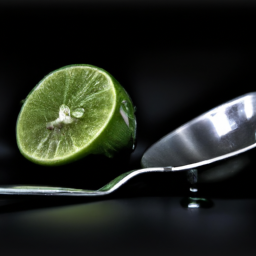I like starting my morning with a glass of freshly squeezed orange juice. It’s not only a refreshing and hydrating way to begin the day, but it’s also packed with the vital vitamins and minerals my body needs to function at its best.
If you’re looking to enjoy the benefits of homemade orange juice, then you’ve come to the right place! In this article, I will guide you through the process of juicing oranges in a juicer so that you can enjoy the taste and health benefits of this citrus fruit anytime you want.
Before we dive into the specifics, let’s talk about why juicing oranges is a great idea. Oranges are an excellent source of vitamin C, which is essential for a healthy immune system and can also help with collagen production, wound healing, and iron absorption. They also contain other vitamins and minerals like folate, potassium, and thiamin, which are important for overall health and wellbeing.
By juicing oranges at home, you can ensure that you’re getting all of these nutrients in a fresh and natural form, without any added sugars or preservatives.
So let’s get started and learn how to juice oranges in a juicer!
Key Takeaways
- There are two types of juicers: centrifugal and masticating, and choosing the right juicer is important for extracting the maximum amount of juice.
- Ripe, juicy oranges with a bright, vibrant color are best for juicing, and washing them before juicing removes dirt, debris, or bacteria.
- Firmly pressing oranges against the juicer’s feeding tube maximizes the amount of juice extracted, and straining the juice through a fine mesh strainer removes any pulp or seeds for a smooth and pulp-free juice.
- Freshly squeezed orange juice should be poured into a sealed container and refrigerated immediately, and it should be consumed within 24-48 hours to ensure maximum benefits.
Choose the Right Juicer
You’ll want to make sure you’re using the right kind of juicer for the job – one that can handle the tough skin and pulp of oranges and extract the maximum amount of juice.
There are two types of juicers: centrifugal and masticating. Centrifugal juicers are generally less expensive and work by using a fast-spinning blade to extract juice from fruit and vegetables. On the other hand, masticating juicers are more expensive but tend to be more efficient and produce a higher yield of juice. They work by slowly crushing and grinding the produce to extract the juice.
When considering a juicer, it’s important to do a price comparison and research the features of different models in order to find one that fits your budget and needs.
While a centrifugal juicer may be a good option for those on a budget, a masticating juicer may be worth the investment for those who plan to juice frequently or want the highest possible yield of juice.
Once you’ve selected the right juicer, it’s time to move on to selecting the best oranges.
Select the Best Oranges
To get the tastiest juice, it’s best to choose ripe, juicy oranges with a bright, vibrant color. When choosing oranges for juicing, it’s important to pick ones that are plump and heavy for their size, which indicates they are full of juice.
The skin should be smooth and firm, with no soft spots or blemishes. If possible, opt for organic oranges to avoid any harmful pesticides or chemicals. Look for oranges that have no bruises, cracks, or mold.
If you’re not sure if an orange is ripe, give it a gentle squeeze – it should be slightly soft but not mushy. Choosing the right oranges is the first step to getting delicious, nutritious juice.
Now, let’s move on to washing and prepping the oranges.
Wash and Prep the Oranges
Before starting, make sure you’ve got fresh, clean oranges so that your juice is not only delicious but also free of any harmful substances. It’s advisable to use organic oranges as they are free from harmful pesticides and chemicals. Organic oranges also have more nutrients and antioxidants than their non-organic counterparts. Additionally, be sure to give your oranges a good wash before using them to remove any dirt, debris, or bacteria that may be present on the skin.
When it comes to peeling oranges, there are a few tips and tricks that can make the process much easier. One such tip is to roll the oranges on a hard surface before peeling them. This helps to loosen the skin and make it easier to remove. Another way to make peeling easier is to cut off the top and bottom of the orange, then slice down the sides to remove the peel in sections. With these tips in mind, you’ll be able to prepare your oranges quickly and efficiently, ready to juice them in your juicer.
Set up the Juicer
Once you’ve got everything ready, it’s time to get the juicing show on the road! Set up your trusty juicer and get ready to create some liquid gold.
To start, make sure the juicer is properly assembled according to the manufacturer’s instructions. Place a glass under the spout to catch the juice, and have a bowl nearby to hold the leftover pulp.
Next, consider the juice consistency and juicing efficiency. If you prefer a pulpier juice, use a juicer with a pulp collector or let some pulp flow through into the juice. If you want a smoother consistency, use a fine mesh strainer to remove any pulp.
To get the most juice out of each orange, cut them into halves or quarters and press them firmly against the juicer’s feeding tube.
With these tips in mind, it’s time to juice the oranges and enjoy the fresh, tangy taste of a perfectly juiced orange.
Juice the Oranges
Now that the juicer’s set up, it’s time to start juicing! To begin, I simply feed the oranges into the juicer. I make sure to remove any seeds or large pieces of pulp. As the juicer grinds and extracts the juice, I can see the fresh orange juice flowing out into the container.
It’s important to collect the juice right away to ensure maximum freshness and nutrient retention.
Feed the Oranges into the Juicer
To begin juicing your oranges, simply cut them in half and feed them into the juicer chute, making sure to apply gentle pressure. This juicing technique will help preserve the maximum amount of juice from your oranges.
If your oranges are too large for the chute, you can cut them into smaller pieces so they fit properly. Additionally, make sure to remove any seeds before putting them in the juicer to avoid any damage to the juicing mechanism.
Juicing tips include using ripe oranges for the best flavor and juicing experience. You can also experiment with different types of oranges, such as navel or blood oranges, to add variety to your juice.
Once you have fed all your oranges into the juicer, you can move onto the next step of collecting the fresh juice.
Collect the Fresh Juice
After feeding the halved oranges into the machine, the freshly squeezed citrus liquid will flow out of the spout and into a glass or container for easy collection. To maximize the juice yield, it’s recommended to use firm and ripe oranges. Rolling the oranges on a hard surface before cutting them in half can also help release more juice.
For those looking to make orange juice cocktails, the freshly squeezed juice can be mixed with sparkling water or your favorite liquor for a refreshing drink. Adding a touch of honey or agave syrup can also balance out the tartness of the citrus.
Once the juice is collected, the next step is to strain it to remove any pulp or seeds.
Strain the Juice
Now that I’ve juiced my oranges, it’s time to strain the juice. I like to use a fine mesh strainer to ensure a smooth and pulp-free juice. This helps to remove any pulp or seeds that may have made their way into the juice during the juicing process.
To achieve this, I simply pour the juice through the strainer into a separate container. It only takes a few minutes, but it’s well worth the effort for a perfectly smooth glass of orange juice.
Use a Fine Mesh Strainer
Using a fine mesh strainer is essential for achieving a smooth and pulp-free orange juice that’ll delight your taste buds. Straining techniques vary from using a spoon to gently push the pulp through the strainer to simply pouring the juice through the strainer and letting gravity do the work. Here are three reasons why using a fine mesh strainer’s the best option when juicing oranges:
-
A fine mesh strainer removes even the tiniest pulp particles, leaving you with a silky smooth juice.
-
A fine mesh strainer catches any seeds that may have sneaked into the juicer, preventing them from getting into your juice.
-
A fine mesh strainer’s easy to clean and store, making it a convenient and practical kitchen tool.
To get the most out of your oranges, it’s important to remove any pulp or seeds that might have made it into the juice. The next step in achieving a pulp-free orange juice’s to use a spoon or spatula to press the pulp against the strainer and extract as much juice as possible.
Remove Any Pulp or Seeds
To ensure a smooth and delightful drinking experience, it’s crucial to eliminate any unwanted pulp or seeds from your freshly squeezed orange. Juicing techniques vary, but here are some easy steps to follow:
First, cut your oranges in half and juice them in a juicer, making sure to catch the juice in a container. Next, use a fine mesh strainer to remove any large chunks of pulp or seeds. Finally, pour the juice through the strainer into a cup or glass.
If you want to skip this step altogether, consider using seedless oranges. By doing so, you can eliminate the need for straining and enjoy a pure, refreshing glass of orange juice without any unwanted bits. With your juice strained and ready to drink, let’s move on to the next step: storing the juice.
Store the Juice
Now that I’ve freshly juiced my oranges, it’s important to properly store the juice to maintain its freshness and nutritional value.
First, I’ll pour the juice into a sealed container–ideally made of glass or BPA-free plastic.
Then, I’ll refrigerate the juice immediately to slow down the oxidation process.
It’s important to consume the juice within 24-48 hours to ensure maximum benefits.
Pour the Juice into a Container
As the freshly squeezed orange juice flows out of the juicer, grab a container to collect the delicious liquid. It’s important to choose a container that’s clean and has a lid to keep the juice fresh and prevent any contamination. Glass jars or plastic bottles with tight-fitting lids work well for storing fresh juice.
When it comes to serving the juice, there are plenty of creative ideas to make it even more enjoyable. You can add a few ice cubes to make it refreshing on a hot day, or mix it with other fruits for a delicious smoothie. Orange juice is also a great addition to cocktails, and can even be used in cooking and baking. Plus, it’s packed with health benefits, such as vitamin C and antioxidants, which can help boost your immune system and improve your overall health.
To keep the juice refrigerated and prevent it from spoiling, make sure to store it in the fridge as soon as possible. It’s recommended to consume fresh juice within 24 hours, as it can lose its nutritional value and taste over time.
By properly storing and serving your freshly squeezed orange juice, you can enjoy its delicious taste and health benefits to the fullest.
Keep the Juice Refrigerated
When you’ve got a container of fresh orange juice, don’t forget to pop it in the fridge to keep it cool and preserve its flavor. Long term storage of orange juice requires refrigeration, as it helps prevent spoilage and the growth of bacteria. Ideally, freshly squeezed orange juice should be consumed within 24 hours of juicing. However, if you want to store it for a longer period, it’s best to keep it in an airtight container in the refrigerator.
When it comes to choosing the best containers for storing juice, opt for glass or plastic containers that are free of BPA. These containers are safe to store juice and can keep it fresh for up to 3 days. It’s important to note that plastic containers can sometimes affect the taste of the juice, so it’s best to use glass containers if possible.
Now that you’ve learned how to keep your freshly squeezed orange juice fresh, it’s time to move on to the next step – cleaning the juicer.
Clean the Juicer
Alright, now that I’ve got my fresh orange juice, it’s time to clean up. First things first, I need to disassemble my juicer. Taking apart the different parts will make it easier to clean thoroughly.
Next, I’ll rinse each piece under running water and scrub them with a brush to get rid of any remaining pulp or residue. It’s important to clean the juicer after each use to maintain its function and hygiene.
Disassemble the Juicer
First off, let’s break down that juicer like a boss so you can get to the good stuff. To disassemble a juicer, start by unplugging it and removing all the removable parts.
Most juicers are made up of a few key components, including the pulp container, juice jug, feed chute, and blade assembly. Each of these parts needs to be taken apart carefully, cleaned, and reassembled correctly to keep your juicer in top condition.
Cleaning the juicer parts is the next step in the process. I recommend using warm, soapy water to scrub each part thoroughly. Be sure to pay extra attention to any nooks or crannies where pulp or juice may have accumulated.
Once the parts are clean, rinse them well with hot water to remove any soap residue. Now that the juicer is disassembled and cleaned, it’s time to move on to the next step: rinsing and scrubbing the parts.
Rinse and Scrub the Parts
Now it’s time for me to give those freshly cleaned juicer parts a good rinse and scrub with a soft-bristled brush to ensure all residue is removed. I prefer using warm water and mild soap to clean the parts thoroughly. Be sure to use a gentle scrubbing technique to avoid damaging the parts.
When it comes to juicing oranges, it’s important to choose the right oranges. I always recommend using organic oranges as they’re free from harmful chemicals and pesticides. But if you can’t find organic oranges, make sure to wash and scrub the non-organic ones thoroughly before juicing to remove any residues.
Once you have your oranges ready, you can move onto the next step – experimenting with flavors.
Experiment with Flavors
Want to take your orange juice to the next level? Try experimenting with different flavor combinations in your juicer! Here are three ideas to get you started:
-
Orange and ginger: Add a small piece of peeled ginger root to your juicer along with the oranges for a spicy and refreshing twist. Ginger has anti-inflammatory properties and can help with digestion, making it a great addition to your morning juice.
-
Orange and carrot: Add a few carrots to your juicer along with the oranges for a sweeter and more nutritious juice. Carrots are rich in vitamin A, which is important for eye health, as well as antioxidants that can help boost your immune system.
-
Orange and mint: Add a handful of fresh mint leaves to your juicer along with the oranges for a cooling and invigorating juice. Mint can help soothe digestive issues and has a refreshing flavor that pairs well with oranges.
By trying out different flavor combinations and taste testing, you can find the perfect blend of ingredients to suit your taste buds. Once you’ve found your favorite combination, enjoy your freshly-squeezed orange juice!
Enjoy Your Freshly-Squeezed Orange Juice!
Savor the deliciousness of your homemade orange juice and start your day off with a burst of citrusy goodness. Drinking freshly squeezed orange juice offers several health benefits such as vitamin C, folate, and potassium. It’s also a great source of antioxidants that can help boost your immune system and fight against diseases.
Aside from drinking it straight up, there are many different ways to use freshly squeezed orange juice. You can use it as a marinade for meats, a base for salad dressings, or as a substitute for vinegar in recipes. Adding freshly squeezed orange juice to your smoothies can also give them a sweet and tangy twist.
The possibilities are endless, so get creative and enjoy the benefits of this refreshing and nutritious fruit juice.
Frequently Asked Questions
How long does freshly squeezed orange juice stay fresh?
I know you’re concerned about the freshness of your orange juice. Storing tips include refrigerating it immediately and consuming within 3-4 days. Preservation techniques like adding lemon juice or using airtight containers can help prevent oxidation and extend shelf life.
Can you use overripe oranges for juicing?
Yes, overripe oranges can be used for juicing. They are sweeter and more flavorful, but have less juice. Use within a day or two. For baking, zest the peel first. Tips: roll oranges before juicing, use a citrus reamer.
Is it necessary to remove the seeds before juicing?
Juicing oranges? To seed or not to seed? It’s not necessary to remove the seeds, but it’s recommended for a smoother juice. Seedless oranges make the juicing process easier and faster. Happy juicing!
How do you adjust the juicer for different sizes of oranges?
To adjust my juicer for different sizes of oranges, I simply adjust the juicer settings. For juicing small oranges, I use the low setting to ensure maximum juice yield. It’s important to use fresh, ripe oranges for the best flavor and health benefits.
Can you add other fruits or vegetables to the orange juice for added nutrition?
I love adding spinach to my orange juice for added nutrition. Leafy greens are packed with vitamins and minerals, and pairing them with oranges in a juicer is a great way to get a delicious and healthy drink. Other great fruits to pair with oranges include grapefruit and strawberries.
Conclusion
In conclusion, juicing oranges can be a great way to enjoy a refreshing and healthy drink. With the right juicer, selecting the best oranges, and proper preparation, you can easily create delicious and nutrient-rich orange juice.
Juicing oranges is like creating a masterpiece. Each step, from choosing the right ingredients to cleaning up afterwards, is important in ensuring that the final product is perfect. By experimenting with different flavors and adding in other fruits or vegetables, you can create your own unique blend of orange juice that’s both delicious and good for your health.
So, grab your juicer and start creating your own masterpiece today!
Ilana has been a vegan for over 10 years. She originally made the switch for health reasons, but soon found herself becoming more and more passionate about the ethical and environmental implications of a vegan lifestyle. Ilana is the author of The Graceful Kitchen, a blog all about veganism. She loves to cook up delicious and nutritious vegan meals, and share her recipes with others who are interested in leading a cruelty-free life. Ilana is also a strong advocate for using whole foods as the foundation of a healthy diet, and believes that going vegan is one of the best ways to achieve this.
